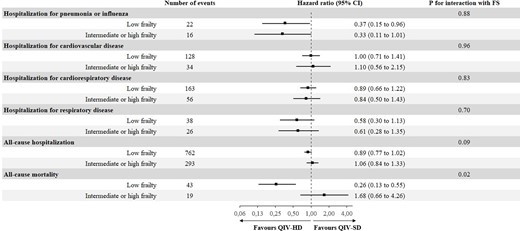-
PDF
- Split View
-
Views
-
Cite
Cite
C Espersen, N D Johansen, D Modin, K H Janstrup, J Nealon, S Samson, C Salamand, M M Loiacono, A M R Jensen, N E Landler, B L Claggett, S Solomon, G H Gislason, L Koeber, T Biering-Soerensen, Relative effectiveness of high-dose versus standard-dose quadrivalent influenza vaccine against hospitalizations and mortality according to frailty score: a post-hoc analysis of the DANFLU-1 trial, European Heart Journal, Volume 45, Issue Supplement_1, October 2024, ehae666.3141, https://doi.org/10.1093/eurheartj/ehae666.3141
Close - Share Icon Share
Abstract
Frailty is a major risk factor for adverse cardiovascular events. Influenza vaccination has been shown to protect against cardiovascular fatal and nonfatal events. However, limited data exist on the added benefit of high-dose versus standard-dose influenza vaccination according to frailty status.
We sought to assess the relative effectiveness of high-dose (QIV-HD) versus standard-dose (QIV-SD) quadrivalent influenza vaccination according to frailty status in elderly individuals.
This is a post-hoc analysis of the randomized controlled feasibility trial of QIV-HD versus QIV-SD conducted during the 2021–2022 influenza season in adults aged 65–79 years. We assessed the following prespecified outcomes: hospitalizations for pneumonia or influenza, cardio-respiratory hospitalizations, cardiovascular hospitalizations, all-cause hospitalizations and all-cause mortality. Level of frailty was defined according to the Hospital Frailty Risk Score based on ICD-10 codes for relevant comorbidities any time prior to vaccination. We divided the participants into two categories according to Frailty Score (FS): low frailty (0-4 points) and intermediate or high frailty (≥5 points). We analyzed outcomes as time to first event using Cox proportional hazards regression.
Among 12,473 randomly assigned participants to QIV-HD versus QIV-SD (mean age 71.7 years, 47.1% female), 10,711 (85.9%) were categorized as having low frailty and 1,762 (14.1%) had intermediate or high frailty. In total, 38 individuals were hospitalized for pneumonia or influenza during follow-up, 219 were hospitalized for cardiorespiratory illness, 1055 were hospitalized due to any cause and 62 died during follow-up. FS significantly modified the effect of QIV-HD versus QIV-SD for all-cause mortality (P for interaction 0.02). In participants with low frailty, QIV-HD was associated with a lower risk of all-cause mortality (Figure 1: HR 0.26, 95% CI 0.13 to 0.55), whereas there was no evidence of effect among those with intermediate or high frailty (HR 1.68, 95% CI 0.66 to 4.26). QIV-HD versus QIV-SD was associated with a lower incidence of hospitalizations for pneumonia and influenza, this effect was consistent regardless of frailty status (P for interaction 0.88). QIV-HD was not associated with a significantly lower incidence of hospitalizations due to cardiovascular, cardiorespiratory or respiratory disease or any cause regardless of frailty status.

Author notes
Funding Acknowledgements: Type of funding sources: Private company. Main funding source(s): Sanofi Pasteur



